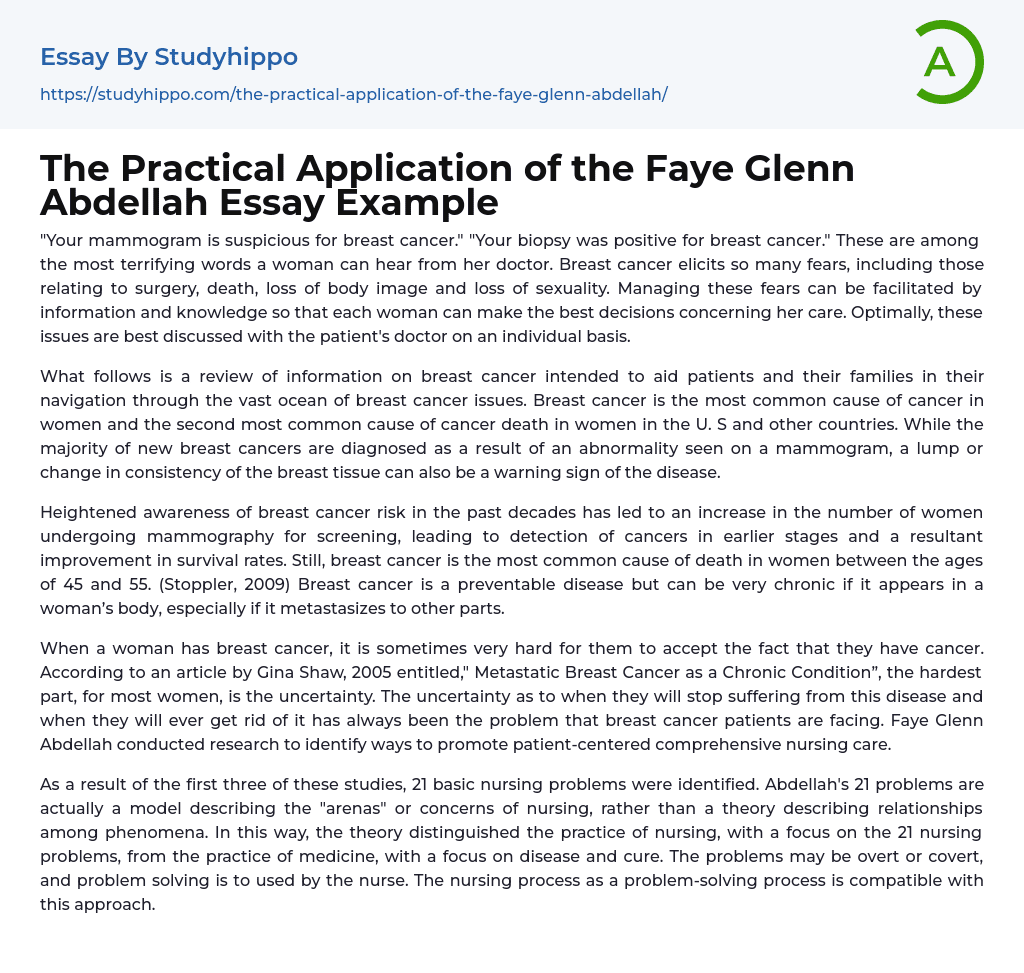

The Practical Application of the Faye Glenn Abdellah Essay Example
"Your mammogram is suspicious for breast cancer." "Your biopsy was positive for breast cancer." These are among the most terrifying words a woman can hear from her doctor. Breast cancer elicits so many fears, including those relating to surgery, death, loss of body image and loss of sexuality. Managing these fears can be facilitated by information and knowledge so that each woman can make the best decisions concerning her care. Optimally, these issues are best discussed with the patient's doctor on an individual basis.
What follows is a review of information on breast cancer intended to aid patients and their families in their navigation through the vast ocean of breast cancer issues. Breast cancer is the most common cause of cancer in women and the second most common cause of cancer death
...in women in the U. S and other countries. While the majority of new breast cancers are diagnosed as a result of an abnormality seen on a mammogram, a lump or change in consistency of the breast tissue can also be a warning sign of the disease.
Heightened awareness of breast cancer risk in the past decades has led to an increase in the number of women undergoing mammography for screening, leading to detection of cancers in earlier stages and a resultant improvement in survival rates. Still, breast cancer is the most common cause of death in women between the ages of 45 and 55. (Stoppler, 2009) Breast cancer is a preventable disease but can be very chronic if it appears in a woman’s body, especially if it metastasizes to other parts.
When a woman has breast cancer, it is sometimes very
hard for them to accept the fact that they have cancer. According to an article by Gina Shaw, 2005 entitled," Metastatic Breast Cancer as a Chronic Condition”, the hardest part, for most women, is the uncertainty. The uncertainty as to when they will stop suffering from this disease and when they will ever get rid of it has always been the problem that breast cancer patients are facing. Faye Glenn Abdellah conducted research to identify ways to promote patient-centered comprehensive nursing care.
As a result of the first three of these studies, 21 basic nursing problems were identified. Abdellah's 21 problems are actually a model describing the "arenas" or concerns of nursing, rather than a theory describing relationships among phenomena. In this way, the theory distinguished the practice of nursing, with a focus on the 21 nursing problems, from the practice of medicine, with a focus on disease and cure. The problems may be overt or covert, and problem solving is to used by the nurse. The nursing process as a problem-solving process is compatible with this approach.
- Pregnancy essays
- Death essays
- Asthma essays
- Chronic Pain essays
- Diabetes essays
- Infection essays
- Infertility essays
- Pain essays
- Sexually Transmitted Disease essays
- Cholesterol essays
- Epidemic essays
- Pathogen essays
- Symptom essays
- Water supply essays
- Myocardial Infarction essays
- Chronic essays
- Hypertension essays
- Black Death essays
- Breast Cancer essays
- Down Syndrome essays
- Apoptosis essays
- Tuskegee Syphilis Experiment essays
- Type 2 Diabetes essays
- Hospital essays
- Physician essays
- Health Care Provider essays
- Universal Health Care essays
- Readmission essays
- Addiction essays
- Anatomy and Physiology essays
- Biodegradation essays
- Cancer essays
- Dental Care essays
- Disability essays
- Disease essays
- Disorders essays
- Health Care essays
- Infectious Disease essays
- Inquiry essays
- Intelligence Quotient essays
- Lung Cancer essays
- Medicine essays
- Neurology essays
- Nutrition essays
- Olfaction essays
- Physical Exercise essays
- Public Health essays
- Sex essays
- Women's Health essays
- World health organization essays



